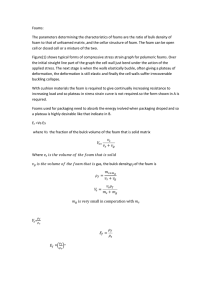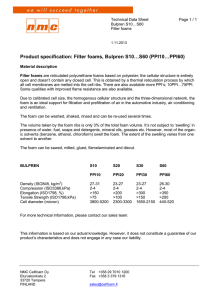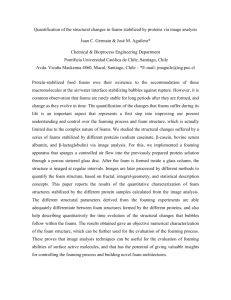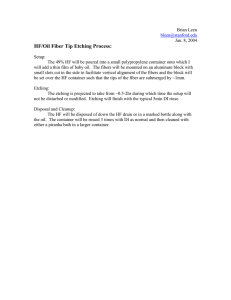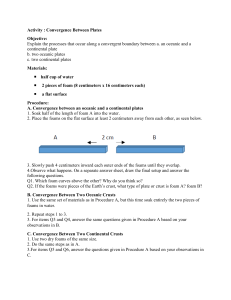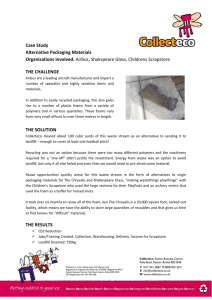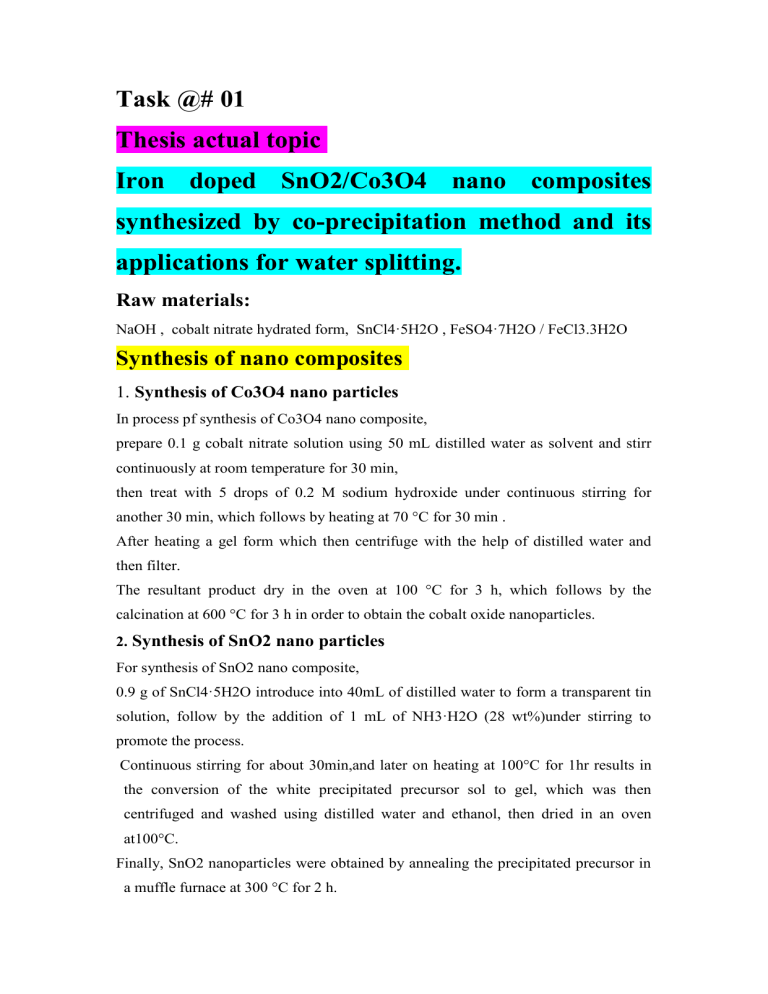
Task @# 01 Thesis actual topic Iron doped SnO2/Co3O4 nano composites synthesized by co-precipitation method and its applications for water splitting. Raw materials: NaOH , cobalt nitrate hydrated form, SnCl4·5H2O , FeSO4·7H2O / FeCl3.3H2O Synthesis of nano composites 1. Synthesis of Co3O4 nano particles In process pf synthesis of Co3O4 nano composite, prepare 0.1 g cobalt nitrate solution using 50 mL distilled water as solvent and stirr continuously at room temperature for 30 min, then treat with 5 drops of 0.2 M sodium hydroxide under continuous stirring for another 30 min, which follows by heating at 70 °C for 30 min . After heating a gel form which then centrifuge with the help of distilled water and then filter. The resultant product dry in the oven at 100 °C for 3 h, which follows by the calcination at 600 °C for 3 h in order to obtain the cobalt oxide nanoparticles. 2. Synthesis of SnO2 nano particles For synthesis of SnO2 nano composite, 0.9 g of SnCl4·5H2O introduce into 40mL of distilled water to form a transparent tin solution, follow by the addition of 1 mL of NH3·H2O (28 wt%)under stirring to promote the process. Continuous stirring for about 30min,and later on heating at 100°C for 1hr results in the conversion of the white precipitated precursor sol to gel, which was then centrifuged and washed using distilled water and ethanol, then dried in an oven at100°C. Finally, SnO2 nanoparticles were obtained by annealing the precipitated precursor in a muffle furnace at 300 °C for 2 h. 3. Synthesis of Fe-doped SnO2/Co3O4 nanocomposites In synthesis for Fe-doped SnO2/Co3O4 nanocomposites, the add FeSO4·7H2O / ferric chloride drop-wise to 50 mL tin and ammonia solution under continuous stirring. Then add 0.06 mol of thiourea drop by drop to mixture at 30 min. The solution then heat at 100 °C for 1 h. Then suspension add to cobalt nitrate solution and stirr under magnetic stirrer for 30 min. Then 5 drops of 0.5 M NaOH add into this solution and then stirr for 60 min. The resultant product dry at 120 °C for 2 h and it was calcine at 600 °C for 3 h. The different molar ratios of Fe doped samples to SnO2/Co3O4 nano composites are (1:1), (1:2) and (2:1) or 2%,4%,6%,8%,10% add to optimize water splitting. Task @ 02 Working methodology of nickel foam Surface Science and Electrochemical Analysis of Nickel Foams (Grdeń, Alsabet et al. 2012) Structure of Nickel Foam Nickel foam is a highly porous material with a three-dimensional open-cell structure. This structure provides a large surface area, allowing for high catalytic activity and efficient electron transport. Nickel foam is robust and mechanically stable, making it suitable for use in harsh electrochemical environments. Role in Water Splitting Electrolysis Substrate: Nickel foam serves as a substrate or support for catalysts used in water splitting. Its high surface area provides ample sites for catalytic reactions, enhancing the efficiency of electrolysis. It can be used for both the anode (where oxygen evolution occurs) and the cathode (where hydrogen evolution occurs). Catalyst Loading: Nickel foam can be coated or impregnated with catalytic materials to improve its performance in water splitting. Common catalysts include nickel-based alloys, transition metal oxides, or noble metals. The porous structure allows for uniform distribution of the catalyst, ensuring efficient contact with the electrolyte. Electron Conduction: Nickel foam is a good conductor of electricity, enabling efficient electron transport during electrolysis. This property is crucial for maintaining a low overpotential and achieving high current densities. Gas Evolution: During water splitting, hydrogen and oxygen gases are produced at the cathode and anode, respectively. The open-cell structure of nickel foam allows gases to escape easily, reducing pressure buildup and minimizing the risk of gas-induced resistance. The porosity also aids in the rapid dispersion of gases, ensuring smooth operation of the electrolysis process. Applications Water Electrolysis: Nickel foam is widely used in electrolyzers for hydrogen production due to its high stability, conductivity, and large surface area. Energy Storage: In addition to water splitting, nickel foam is used in energy storage applications like batteries and supercapacitors, where its porous structure enhances ion transport and electron conduction. Treatment of Nickel Foams. Several approaches were employed to treat Ni foams in order to prepare metallic or oxidized surfaces. In the following sections, the Ni foams denoted as “as-received” were subjected only to cleaning that did not alter their chemical composition. The foams were degreased with hot acetone under reflux, rinsed with deionized water and then sonicated in deionized water. The last step involved short sonication of Ni foams in 0.5 M aqueous KOH solution in order to flood the pores. Nickel foams were also either chemically etched or thermally reduced in an H2(g) atmosphere to produce metallic surfaces. The chemical etching or thermal reduction was preceded by cleaning as described above. Several chemical etching solutions were employed to prepare metallic surfaces but only one yielded the expected result; it is described in detail in Results and Discussion. The thermal reduction was carried out by placing a Ni foam in a quartz tube through which H2(g) (99.999%) at a pressure of ca. 3.0 atm was passed for 2 h and the temperature was maintained at 500 ± 10 °C. Chemically etched and thermally reduced Ni surfaces are denoted as “etched” and “reduced”, respectively. Some Ni foams were subjected to electrochemical passivation that resulted in the formation of β-Ni(OH)2. This was accomplished by repetitive cycling of a Ni foam in the 1.0−1.6 V potential range until a steady-state CV profile was obtained. This approach required ca. 270 cycles and generated a surface that was covered with a thick layer of Ni(OH)2. Such prepared Ni foam surfaces are denoted as “passivated”. Comparative electrochemical measurements were conducted using bulk Ni. A Ni rod of 5.0 mm in diameter (AlfaAesar Puratronic) was sealed in a Teflon sleeve and an electrical contact was made using a threaded stainless steel wire that was screwed into the Ni rod. The Ni rod-wire connection was carefully sealed using a Teflon sleeve (tight fit) and was never exposed to the electrolyte. Prior to each experiment, the Ni rod was mechanically polished with alumina pastes of different grades down to 0.05 μm (Buehler Micropolish Alumina) to obtain a mirror-like surface finish. After the polishing, the electrode was rinsed with deionized water (Millipore) and immediately introduced into the electrochemical cell. In order to avoid any contact with air that could contaminate the electrode surface, the latter was protected during the transfer into the cell with a droplet of deionized water. The surface roughness (R) of such a prepared Ni rod electrode was examined by measuring the charge associated with the formation of α-Ni(OH)2 and was R = 2.10 ± 0.74.30 The surface roughness is defined by eq 1 R = A A/ ecsa g (1) where Aecsa is the electrochemically active surface area and Ag is the geometric surface area. The electrochemically active surface area is the area accessible to electrolyte at which electron transfer takes place and the geometric surface area is a two-dimensional projection of the electrode surface. The Ni rod was also subjected to the same chemical etching as the Ni foam (thermal reduction in an H2(g) atmosphere was impossible due to the presence of Teflon sleeve). This allowed us to evaluate changes in Aecsa brought about by the chemical etching. Characterization of Nickel Foams: shows an SEM micrograph of a Ni foam which reveals the existence of interconnected struts that generate small and large open pores, mainly pentagonal in shape and ca. 50 ± 10 μm and 500 ± 100 μm in size, respectively. The large pores dominate the threedimensional structure and the small pores are observed mostly in the regions where struts interconnect; not all strut interconnections create small pores. Paserin et al. showed that the interior of struts is hollow.18,19 However, the hollow internal structure does not affect the exterior morphology and the struts are found to be mostly compact and fairly uniform, and their surfaces do not show any openings or voids. Chemical Etching to increase metallic sites on nickel foam. (i) generate a metallic surface by removing a native oxide/ hydroxide layer that developed on the foam surface during sintering18,19 and prolonged exposure to moist air;31−34 (ii) increase the surface roughness of Ni foams (rough surfaces are known to be more active than smooth ones); and (iii) modify the electrocatalytic activity of Ni foams (a metallic surface has different electrocatalytic properties than an oxidized one). presents the chemical compositions of four etching solutions and the description of experimental procedure employed. The etching solution 4 was found to be unsuitable for treating Ni foams because it resulted in their total dissolution within less than 1 min. On the other hand, chemical etching in the etching solutions 1 through 3 maintained the integrity of Ni foams. Consequently, we performed CV measurements using Ni foams treated in the etching solutions 1 through 3 with the objective of obtaining a profile characteristic of a metallic Ni electrode. The Ni foams treated in the etching solutions 2 and 3 generated CV profiles (not shown) that did not resemble at all that expected for metallic Ni. However, Ni foams treated in the etching solution 1 generated a CV profile characteristic of a metallic Ni surface demonstrate that there is a linear relationship between the percentage of mass loss and the etching time, for etching times up to 180 s. They also show that the etching for 30 − 40 s results in a 10% mass loss while the etching for 180 s results in a 26% mass loss. It is important to add that mass losses are not only due to dissolution of Ni but possibly also due to detachment of small sections of foams as a result of etching induced breakup of the structure in areas where struts become thin. 1. 30 cm3 conc. HNO3, T = 18−19 °C , 10 cm3 conc. H2SO4 , etching time = 2 min , 10 cm3 conc. H3PO4,50 cm3 glacial CH3COOH no stirring 2. 25 cm3 conc. HNO3 , T = 18−19 °C , 10 cm3 H2SO4 , etching time ≤ 10 min , 25 cm3 glacial CH3COOH , no stirring , 40 cm3 H2O 3. 75 g L−1 KMnO4, T = 75−100 °C ,75 g L−1 Na2CO3 etching time ≤ 10 min, H2O to 1 L, no stirring 4. 120 cm3 conc. H2SO4 , T = 85 °C , 90 g L−1 KNO3 etching time ≤ 2 min , 90 g L−1 NaCl stirring H2O to 1 L Reference: Grdeń, M., et al. (2012). "Surface science and electrochemical analysis of nickel foams." ACS applied materials & interfaces 4(6): 3012-3021.
